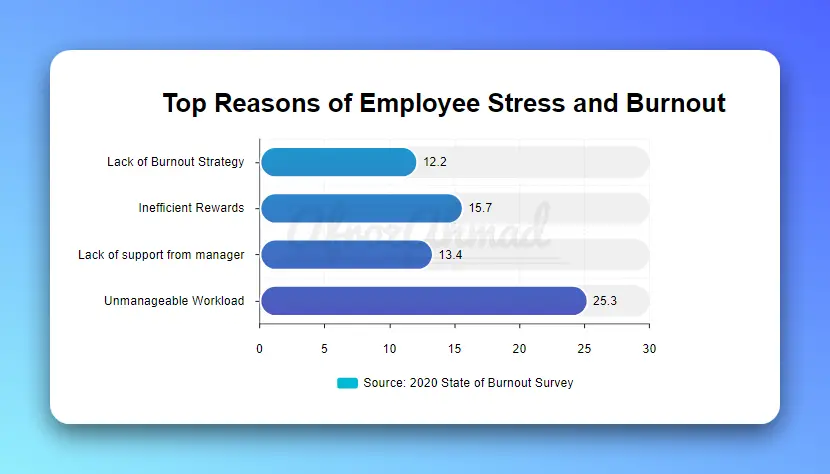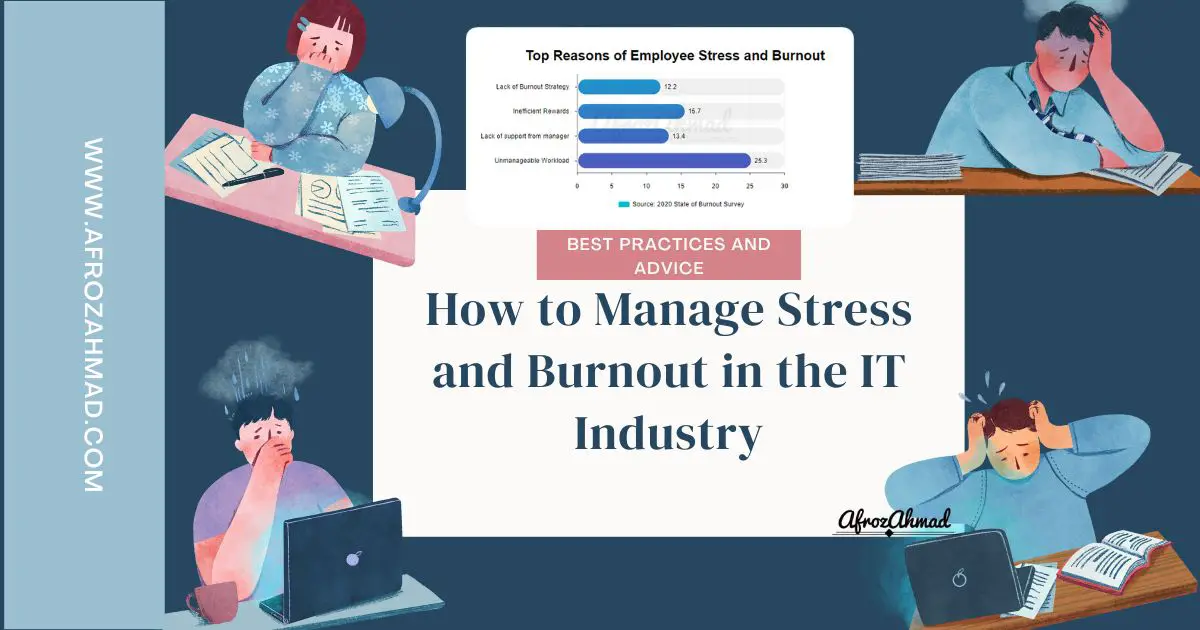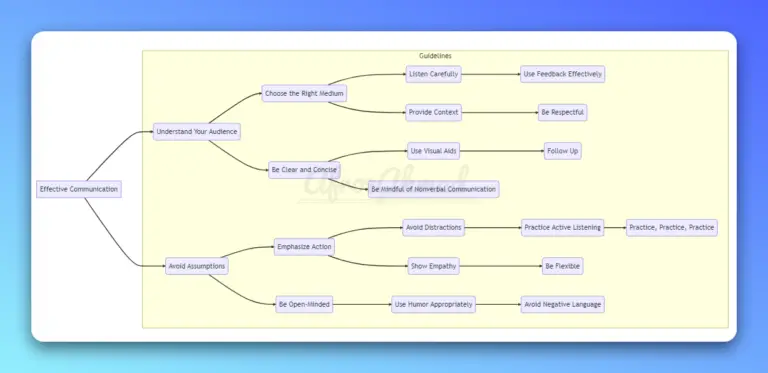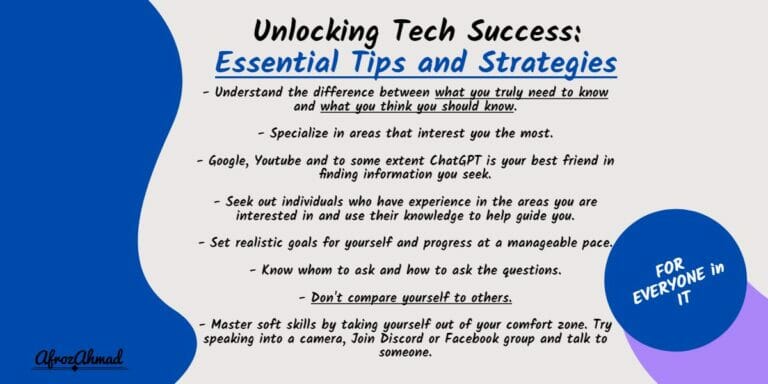- How to manage stress and burnout in the IT industry?
- What causes stress and burnout in the IT industry?
- Know Thy Enemy: How to Recognize the Signs of Burnout and Stress?
- How to Manage Stress and Burnout in the IT Industry? (Best Practices and Advice)
- 1. Create a Supportive Work Environment
- 2. Prioritize, Prioritize, Prioritize
- 3. Keep It Real: Set Realistic Expectations
- 4. The Power of "No"
- 5. Master Time Management
- 6. Automate, Automate, Automate
- 7. Take Regular Breaks
- 8. Strike a Work-Life Balance
- 9. Relax and Unwind
- 10. Get Moving
- 11. Embrace Mindfulness
- 12. Think Positive
- 13. Reach Out for Help
- 14. Develop Emotional Intelligence
- 15. Catch Those Z's
- 16. Eat for Your Brain
- 17. Speak Up with Assertive Communication
- 18. Bond with Your Team
- 19. Reflect and Grow
- Effective Strategies to Manage the Top Reasons for Stress and Burnout:
- Conclusion
“It’s not the load that breaks you down; it’s the way you carry it.” – Lou Holtz.
The tech and IT industry is constantly evolving, and with this comes an increased level of stress and burnout among professionals. A recent study found that 57% of IT professionals experience high levels of stress and 34% report burnout. This is a cause for concern as stress and burnout can lead to a decrease in productivity, creativity, and overall well-being. In this article, we will explore the causes of stress and burnout in the IT industry and provide practical solutions to manage them.
Whether you’re a network engineer, developer, designer, project manager, or any other type of IT professional, these tips can help you stay focused, motivated, and productive throughout your career. So sit back, relax, and let’s dive in!
Make sure you read my blog posts covering various topics in our IT industry:
- How to be Successful in IT Industry: Essential Tips and Strategies
- How to Navigate the World of Network Engineering in 2023: Fundamentals, Trends, and Solutions
How to manage stress and burnout in the IT industry?
By following the below strategies, you can manage stress and burnout in the IT industry:
Key Strategies to Manage Stress and Burnout:
| Strategy | Short Description |
|---|---|
| Use stress management techniques | Practice relaxation techniques to manage stress |
| Prioritize tasks effectively | Rank tasks based on their importance and urgency |
| Seek support | Connect with colleagues, friends, or family members |
| Use time management skills | Use effective time management techniques |
| Stay active | Incorporate physical activity into your daily routine |
| Practice mindfulness | Stay present in the moment and focus on your thoughts |
| Get adequate sleep | Ensure you get enough sleep each night |
| Eat healthily | Incorporate nutrient-rich foods into your diet |
| Take breaks frequently | Take regular breaks throughout the workday |
| Use positive thinking strategies | Reframe negative thoughts and emotions |
| Develop communication skills | Effectively communicate with colleagues and management |
| Delegate tasks and work as a team | Delegate tasks and collaborate with colleagues |
| Develop emotional intelligence | Recognize and manage emotions |
| Avoid multitasking | Focus on one task at a time |
| Set realistic goals | Establish achievable goals and celebrate progress |
| Practice self-care | Engage in activities that bring you joy and relaxation |
| Use counseling services | Seek professional help if you need it |
What causes stress and burnout in the IT industry?
The IT industry is a fast-paced and ever-changing field that demands constant adaptation and evolution. This can result in long hours, tight deadlines, and a heavy workload, all of which contribute to stress and burnout.
As per the Blind 2020 state of Burnout survey, the top reason for stress and burnout are:-
- Unmanageable Workload
- Lack of support from the manager
- Inefficient Rewards
- Lack of Burnout Strategy

Additionally, the following factors can also contribute to stress and burnout in the IT industry:
- Poor work-life balance
- Limited opportunities for career growth
- Working in a highly competitive environment
- Excessive multitasking
- Unclear expectations from employers or colleagues
Know Thy Enemy: How to Recognize the Signs of Burnout and Stress?
First things first, let’s learn how to spot stress and burnout. Be on the lookout for:
- Feeling exhausted, irritable, or overwhelmed,
- Having difficulty concentrating or sleeping,
- Losing interest in activities you once enjoyed,
- Emotional exhaustion, cynicism, and a diminished sense of accomplishment.
- Experiencing physical symptoms like headaches or stomachaches.
Catching these early signs is key to nipping them in the bud.
How to Manage Stress and Burnout in the IT Industry? (Best Practices and Advice)
“Give your stress wings and let it fly away.” – Terri Guillemets
Let’s dive into the best practices and advice on managing stress at the workplace.
1. Create a Supportive Work Environment
A happy workplace is a productive one. Encourage open communication, and let your colleagues know that they can lean on you. When everyone feels supported, stress and burnout are less likely to take hold.
2. Prioritize, Prioritize, Prioritize
A well-organized workload is your best friend when it comes to managing stress. Break tasks down into smaller, manageable chunks, and tackle the most important ones first. You’ll be amazed at how much more in control you feel!
3. Keep It Real: Set Realistic Expectations
Don’t bite off more than you can chew. Set achievable goals for yourself and your team, and you’ll create a much healthier work environment.
4. The Power of “No”
Sometimes, the best thing you can do for yourself is to say “no” when you’re already swamped. It might be tough, but it’s crucial for keeping stress at bay.
5. Master Time Management
The clock is ticking, but that doesn’t mean you have to be a slave to it. Learn time management techniques like the Pomodoro method and time blocking to maximize your productivity while minimizing stress.
6. Automate, Automate, Automate
Tech is your friend, so use it to automate repetitive tasks. You’ll save time and reduce stress in the process.
7. Take Regular Breaks
Give your brain a breather! Short breaks throughout the day can do wonders for your creativity and problem-solving abilities.
8. Strike a Work-Life Balance
All work and no play is a recipe for burnout. Set boundaries between your personal and professional life to ensure you have time to recharge.
9. Relax and Unwind
“Almost everything will work again if you unplug it for a few minutes, including you.” – Anne Lamott
Explore relaxation techniques like deep breathing, progressive muscle relaxation, and visualization. These practices can help you stay calm and focused in even the most stressful situations.
10. Get Moving
Exercise has a whole host of benefits, including improved mood and reduced stress. Find an activity you enjoy and make it a part of your routine.
11. Embrace Mindfulness
“The greatest weapon against stress is our ability to choose one thought over another.” – William James
Mindfulness practices like meditation and yoga can help you stay centered and focused, which is a major asset in the IT industry.
12. Think Positive
A positive mindset can do wonders for your stress levels. Reframe challenges as opportunities for growth, and you’ll be amazed at how resilient you become.
13. Reach Out for Help
Sometimes, professional support is the way to go. Counseling and therapy can provide valuable insights and coping strategies for managing stress and burnout.
14. Develop Emotional Intelligence
“Do not anticipate trouble or worry about what may never happen. Keep in the sunlight.” – Benjamin Franklin
Understanding your own emotions, as well as those of your colleagues can lead to improved communication and collaboration. Plus, it’s great for your overall well-being!
15. Catch Those Z’s
A good night’s sleep is essential for maintaining mental and physical health. Prioritize sleep hygiene and make sure you’re giving your body the rest it needs. Establish a regular sleep schedule, create a calming bedtime routine, and optimize your sleep environment for the best possible slumber.
16. Eat for Your Brain
What you eat can have a huge impact on your mental well-being. Focus on a well-balanced diet that’s rich in nutrients, stay hydrated, and try to limit your caffeine intake. Your brain will thank you!
17. Speak Up with Assertive Communication
Clear and respectful communication is key to reducing stress in the workplace. Practice assertive communication techniques to address conflicts and misunderstandings, and watch as your work environment becomes more harmonious.
18. Bond with Your Team
Team-building activities can help create a more cohesive and stress-resistant group. Give group outings, escape rooms, or volunteering a shot—you might be surprised at how much fun you have!
19. Reflect and Grow
Taking time for self-reflection can provide valuable insights into the sources of your stress and burnout. Regularly check in with yourself to identify patterns, learn from your experiences, and adapt your strategies to better manage stress.
Effective Strategies to Manage the Top Reasons for Stress and Burnout:
Now you know the basics of managing stress, let’s address the elephant in the room, aka effective strategies to manage the top reasons behind employee Burnout:-
Tackling Unmanageable Workload
- Prioritize tasks: Break your workload down into smaller, manageable tasks and rank them based on urgency and importance. This will help you focus on the most critical tasks first and prevent feelings of overwhelm.
- Set realistic expectations: Be honest with yourself and others about what you can accomplish within a given time frame. Communicate your capacity and limits to your manager and colleagues to avoid over-committing.
- Learn to delegate: Share your workload with colleagues when appropriate. Delegating tasks not only reduces your burden but also fosters teamwork and collaboration.
Addressing Lack of Support from Manager
- Communicate your needs: Openly discuss your concerns and needs with your manager, and ask for the specific support or resources you require. Clear communication can help bridge gaps in understanding and expectations.
- Seek feedback: Regularly ask for feedback from your manager to ensure you are on the right track and address any concerns they may have.
- Build a support network and strong relationships outside your organization: Connect with colleagues, friends, or professional networks to create a circle of support outside of your immediate manager.
Improving Inefficient Rewards
- Discuss your expectations: Have a conversation with your manager about your expectations regarding rewards and recognition. Share your thoughts on what would be most meaningful and motivating for you.
- Set performance goals: Establish clear performance goals and discuss them with your manager. This will help you work towards tangible achievements and provide a basis for rewards and recognition.
- Celebrate small victories: Recognize your own accomplishments, both big and small. Celebrate your successes and use them as motivation to continue working towards your goals.
Implementing Burnout Prevention Strategies
- Practice self-care: Make time for activities that recharge and rejuvenate you, such as exercise, hobbies, or spending time with friends and family.
- Maintain work-life balance: Set boundaries between your professional and personal life, and ensure that you have enough time to rest and engage in activities that bring you joy.
- Foster a positive work environment: Encourage open communication, collaboration, and mutual support among your colleagues. A positive work atmosphere can help prevent burnout and promote overall well-being.
Conclusion
In conclusion, managing stress and burnout in the IT industry is all about adopting a well-rounded approach. From prioritizing your workload to engaging in self-care, there are plenty of techniques you can use to keep stress at bay. By implementing these best practices, you’ll not only improve your mental well-being but also enhance your productivity, creativity, and job satisfaction. So go ahead and give them a try—you’ve got this!
- Epson EpiqVision Flex CO-W01 Projector Review - February 21, 2025
- How to Log in to Your Netgear Router - January 17, 2025
- Gaimoo GM200 Mini Projector Review - January 12, 2025




